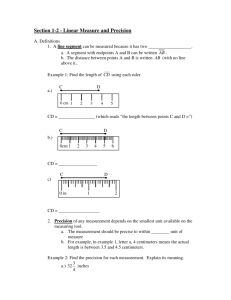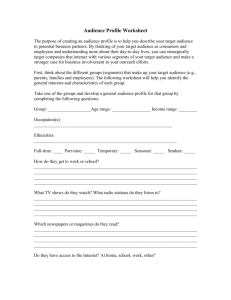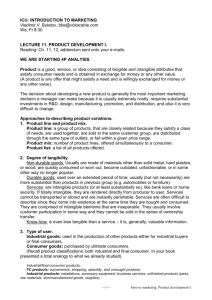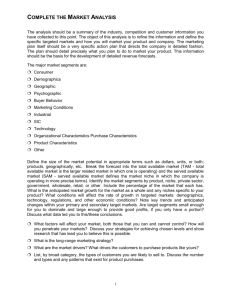Click Here to Template Business Plan Part 2 Market
advertisement
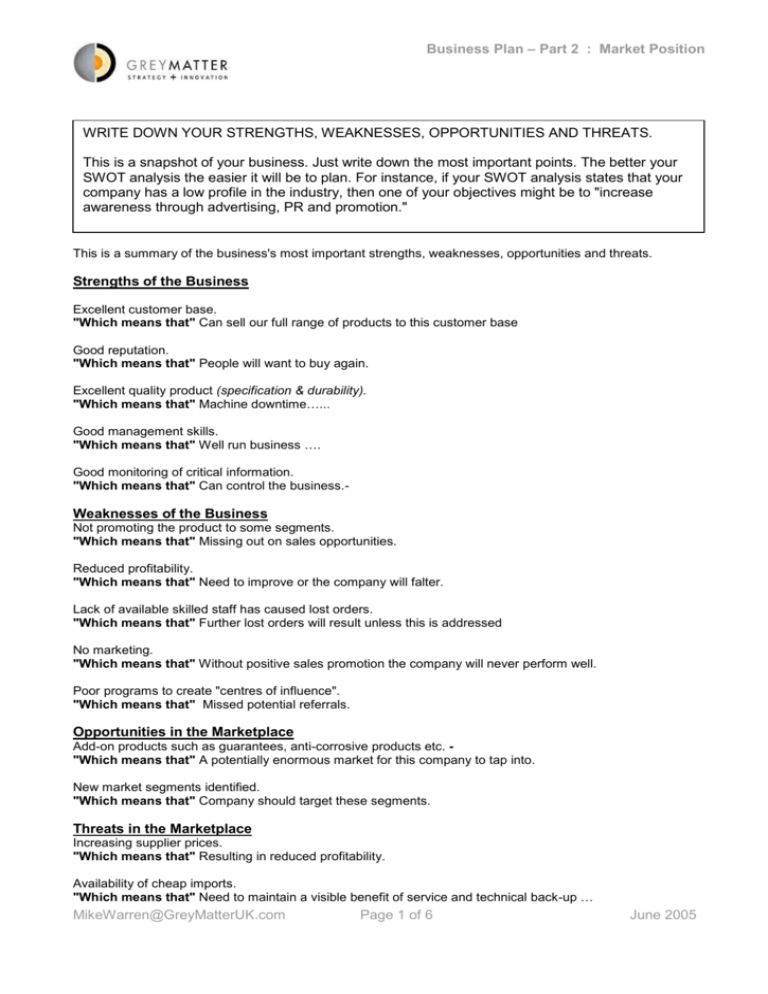
Business Plan – Part 2 : Market Position WRITE DOWN YOUR STRENGTHS, WEAKNESSES, OPPORTUNITIES AND THREATS. This is a snapshot of your business. Just write down the most important points. The better your SWOT analysis the easier it will be to plan. For instance, if your SWOT analysis states that your company has a low profile in the industry, then one of your objectives might be to "increase awareness through advertising, PR and promotion." This is a summary of the business's most important strengths, weaknesses, opportunities and threats. Strengths of the Business Excellent customer base. "Which means that" Can sell our full range of products to this customer base Good reputation. "Which means that" People will want to buy again. Excellent quality product (specification & durability). "Which means that" Machine downtime…... Good management skills. "Which means that" Well run business …. Good monitoring of critical information. "Which means that" Can control the business.- Weaknesses of the Business Not promoting the product to some segments. "Which means that" Missing out on sales opportunities. Reduced profitability. "Which means that" Need to improve or the company will falter. Lack of available skilled staff has caused lost orders. "Which means that" Further lost orders will result unless this is addressed No marketing. "Which means that" Without positive sales promotion the company will never perform well. Poor programs to create "centres of influence". "Which means that" Missed potential referrals. Opportunities in the Marketplace Add-on products such as guarantees, anti-corrosive products etc. "Which means that" A potentially enormous market for this company to tap into. New market segments identified. "Which means that" Company should target these segments. Threats in the Marketplace Increasing supplier prices. "Which means that" Resulting in reduced profitability. Availability of cheap imports. "Which means that" Need to maintain a visible benefit of service and technical back-up … MikeWarren@GreyMatterUK.com Page 1 of 6 June 2005 Business Plan – Part 2 : Market Position HOW DO YOU COMPARE TO YOUR COMPETITORS? Is your competition is faster / smarter / nicer /cheaper? Why should people buy from you? Choose a marketing mix that suits your company. Price, quality, service, payment terms, delivery time, added value, how you sell, etc. The list below is just an example. Detailed Competitor Profile: Marketing Mix Price Strategy Price of best-seller Payment Terms Customer Service Guarantees Added value Reliability Product Life Country of Origin Promotion No of Reps Advertising Appeal YOU Market average £615 30 days Local Competitor Always undercuts price £500 7 days National Competitor Top-end prices £595 7 Days 12 months Excellent Excellent Average 5 years UK Manufacture None stated Poor Medium Assume 3 years Imported Word of mouth / established 3 "We will never be beaten on price" 24 months Excellent Medium Assume 3 years Local Ads in all trade press 10 "The specialist healthcare Widget experts" 2 "The Best" MikeWarren@GreyMatterUK.com Page 2 of 6 June 2005 Business Plan – Part 2 : Market Position KNOW WHO YOUR BEST CUTOMERS ARE: Explain who will buy your products or services. Is this a good, strong, growing market or is it declining? If it is declining you should consider diversifying into other markets. How big is the market is in your area? How many competitors there are? How many specialise in the same product and services as you do. If you are trying to find out how big the market is, try contacting the association that covers your product or service. Or contact the local authority business service to enquire about their published statistical information. Contact a number of your larger customers and ask them how many of these type of products they would sell – what market share do they think they have? You need to establish some reliable sources of information for your product or service. The total market for < Your Product > within the geographic area in which we operate consists of just about any situation where................. Although the market for < Your Product > has become much more competitive, there are still significant opportunities in ………… ………………………………………………………………………………………………………………………… And our research indicates an increasing use of these products in one form or another and this has remained fairly stable over the last few years. Westward < Your Product > current sales are approximately £xxxxx which would equate to a 20% share of the available market. Other markets being considered are: …………………………………………………….. ……………………………………………………….. MikeWarren@GreyMatterUK.com Page 3 of 6 June 2005 Business Plan – Part 2 : Market Position CAN THE TOTAL MARKET BE BROKEN DOWN INTO SMALLER SUB-MARKETS OR MARKET SEGMENTS ? Try to break down the total market into smaller segments. This will help to develop your plans and competitively position your products and services. A quick example: If you are selling computers you might segment your market into large businesses, small businesses, the home buyer, government bodies and students. When you break down your market into smaller segments such as this it is easier for you to decide how to sell your goods or services to each segment. For example, you may need to sell your computers at a low price to students and to sell them through the university magazine. However, to government bodies price would be less of a consideration than reliability. You may also need to employ a sales rep to sell effectively to government bodies. Within the total market ACME has identified several different types of customers with different types of selling needs. These types of companies have been identified as < Your Product > users with.......... < Your Product > users with......... < Your Product > users with.......... < Your Product > users with......... < Your Product > users with......... NEW PRODUCT AND OPPORTUNITY. In addition to this traditional market, by talking to customers we have also discovered that add-on products and other associated services are worth around £100,000 a year. This is an area that ACME could very easily diversify into to rapidly expand the business. MikeWarren@GreyMatterUK.com Page 4 of 6 June 2005 Business Plan – Part 2 : Market Position The diversification into these other markets will be detailed in a report to be released next month evaluating these product opportunities. The rest of this plan will concentrate on getting the core of our business correctly positioned to maintain and strengthen our X% market share position. WARNING: There are trends in the market that are undermining ACME < Your Product’s > strong competitive position. The company must adapt to these trends now or face the consequences. . . . …………………………………………………………………………………………………………………………….. The ideal customer, for ACME would be a …………………………………. working for a company located within a 50 mile radius of ACME who controls a budget. This person is likely to be working in the ………………………………….. industry ARE THERE ANY MARKET TRENDS THAT WILL AFFECT YOUR BUSINESS? It is very important to know and recognise the trends and the external factors that could affect the market, so you can asses whether or not your business will be viable in the long term. Are there any cultural, legislative, social, environmental, technological or other influences that may affect your business? For example, technological influencers have made typewriters and telexes almost obsolete. Look at your products, services and markets and asses whether there are any potential threats or opportunities that could affect your planning. Over the last five years there have been trends in the market that have led to the changing importance of the various market segments. In the past ACME has always concentrated on the xxxxxxx segment. Last year's xxxxxx segment was 50 percent of the total market. However, it can be seen from the pie chart below that this segment is rapidly declining due to xxxxxxxxx whilst other segments, such as the xxxxxx segment, are growing. For ACME to survive we will need to target our future efforts to the growing segments. The xxxxxxxxxxx market's decline from 50% of the market to 35% is primarily due to .................. The yyyyyyyy segments have increased in relative importance significantly over the last five years.These trends are expected to continue over the next few years. ACME has traditionally focused on the xxxxxxxxxx market. Over the next few years we will start to direct more programs at these other two growing segments.we can gain a considerable share of these two segments because of its superior service and technical capabilities. MikeWarren@GreyMatterUK.com Page 5 of 6 June 2005 Business Plan – Part 2 : Market Position Previous Market Mechanical Valves Electro-mechanical valves Previous Market 95% 5% 100% Mechanical Valves Electromechanical valves Current Market Mechanical Valves Electro-mechanical valves Current Market 75% 25% 100% Mechanical Valves Electromechanical valves In addition to the overall trend in the market – The company has looked at it’s own customer base over the last three years. We have classified our customers into: “A” Customers This is the group of customers that are currently contributing the highest sales and profits OR are customers that offer the most growth opportunity for profit and sales contribution. In this case, customers that provide significant business (contributed over 5% total profit) and have further potential to grow were in this category. If customers have no growth potential and do not match the strategic goals of the company, they are not “A” customers. “B” Customers This group of customers are those with modest (or stable) growth potential and match the company’s business objectives. If the large customer is a business that is stable but offers no growth potential, it would appear here. Also in this group are New Potential Customers (targets) who match the business objectives but are not yet a significant part of the business. “C” Customers This group of customers are those with no growth (or shrinking) potential AND/OR do not match the company’s strategic objectives. This is a group of customers that the company may decide to “fire” depending on the level of support they require. If very little support is required to support their business, and they very infrequently buy, they certainly can remain a customer; but there should be very little focus on them. MikeWarren@GreyMatterUK.com Page 6 of 6 June 2005


